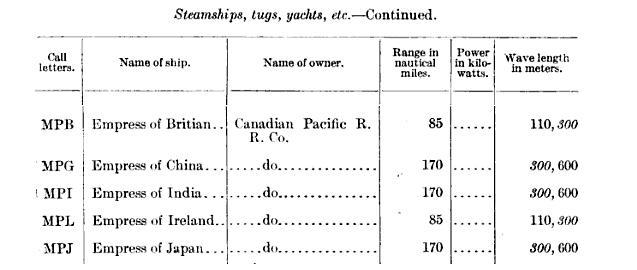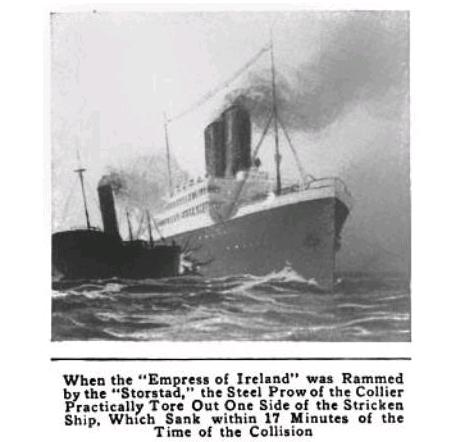The 1912 edition of Wireless Telegraph Stations of the World notes that the Canadian steamer RMS Empress of Ireland was equipped with a wireless set capable of 85 nautical miles, operating on 110 and 300 meters. She bore the call sign MPL.
A hundred years ago, the wireless operator Edward Bomford was called upon to send the distress call SOS DE MPL, signalling the greatest peacetime maritime loss in Canadian history. 1012 souls (840 passengers and 172 crew) perished during the early morning hours of May 29, 1914, following a collision with the Norwegian collier SS Storstad. The steamer had just begun her voyage from Quebec City to Liverpool, England. The harbor pilot had just disembarked at Pointe-au-Père, Quebec, and Captain Henry George Kendall was taking the ship on its normal outbound course. He sighted the lights of the Storstad several miles distant, but ultimately lost sight of the coal ship in the fog. At about 2:00 AM, the Storstad crashed into the side of the Empress.
The Storstad was relatively undamaged, but the Empress sunk in the approximate 40 meters of water in about 15 minutes, leaving little time to evacuate the ship of the mostly sleeping passengers.
Bomford, the young wireless operator, had just relieved operator Ronald Ferguson. An officer ran to the wireless house with orders from the Captain, but Bomford was already at the key, calling the station at Pointe-au-Père. He made contact with Pointe-au-Père operator Crawford S. Leslie. Leslie and other operators quickly notified the government boats Eureka and Lady Evelyn. The Eureka had steam up, having just taken the mails to the Empress. The Eureka got under way immediately, followed closely by the Lady Evelyn. They found the surface of the water calm, dotted with a few lifeboats and debris. Some survivors were taken aboard, some of whom succumed to exposure after exposure to the cold waters of the St. Lawrence, the temperatures that night being just a few degrees above freezing.
The survivors were taken to Rimouski, Quebec, a town of about 2000. That town’s doctors scurried from house to house to treat the survivors quartered there. Most of the town’s population, having been alerted by telegraph, was present at the wharf to meet the survivors, eager to provide whatever help that was possible, carrying blankets, hot coffee, food, and medicine. Among those assisting with the relief efforts was John McWilliams, one of the wireless operators from Pointe-au-Père, who had hastily gone to Rimouski to help render aid. According to one account, few gained more praise than was accorded to him for his efforts.
Both of the wireless operators, Bomford and Ferguson, as well as Captain Kendall, were among the survivors. I haven’t been able to find any information about Bomford (whose name is spelled Bamford in some accounts). There was an Edward Bamford born in 1887 who was awarded the Victoria Cross in 1918. This is almost certainly a different person, since this Edward Bamford had enlisted in the Royal Marines in 1905, where he served until his death in 1928.
The chief radio officer Ferguson, was later a licensed ham, G4VF. He was picked up by the Storstad, and later transferred to one of the tugboats assisting in the rescue. Since the tug had left hastily with no wireless operator aboard, Ferguson was given permission to smash the lock on the tug’s wireless and put it on the air to help coordinate the rescue efforts. Ferguson died in 1985 at the age of 91.
Over a thousand perished that night. Canadian and Norwegian inquiries reached conflicting conclusions as to the blame for the collision. The Canadian inquiry largely placed the blame on the captain of the Storstad, while the Norwegian inquiry largely blamed the Canadian captain.
References:
- Logan Marshall, The Tragic Story of The Empress of Ireland (1914).
- Popular Mechanics, July 1914
- G4VF and the Empress of Ireland
- Empress of Ireland at Wikipedia
Read More at Amazon:
Young readers will enjoy the young-adult novel Second Watch by Karen Autio. It is the story of an 11-year-old girl’s dream to visit her grandparents in Finland, and her trip on the Empress.
Canadian readers can find the following books at amazon.ca:
En francais:
Click Here For Today’s Ripley’s Believe It Or Not Cartoon ![]()



in 1914 remains the largest peacetime maritime disaster in Canada s history. The Liverpool-bound passenger steamer sank in the turbulent waters of the St. Lawrence River within minutes of being accidently hit on the starboard side by a Norwegian collier in dense fog near Rimouski, Quebec. Of the 1,477 people aboard, 1,012 perished.